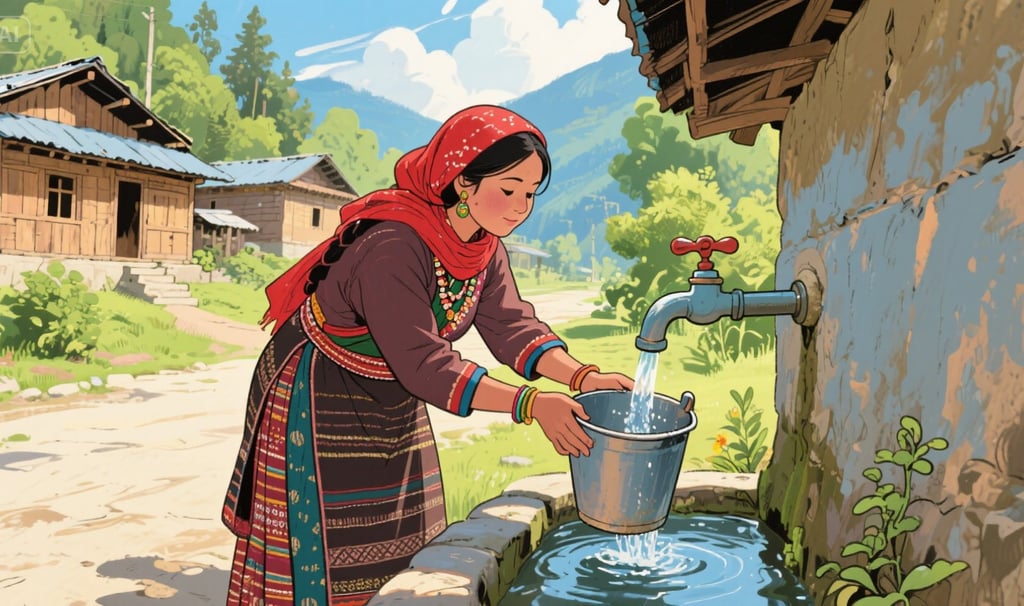Water Springs in Nepal
Blog post description.
Naresh Newar
8/8/20254 min read
Where the springs go silent
Walk a ridge trail at dawn in Nepal’s mid hills and you will still meet someone carrying water. In many wards that walk is longer than it used to be because the source itself is failing. A national survey of local governments captured the pattern clearly. Leaders from 300 municipalities and rural municipalities reported dried springs in nearly three quarters of their areas. Almost half described the problem as medium to severe, and they most often pointed to road cuts and other construction as the top trigger, with earthquakes and changing rain close behind. Some places are already seeing people move for water. (BioOne)
Springs remain the backbone of daily supply for the mountains and mid hills. A 2024 review put the number at about ten million people in Nepal who depend on them, set within a larger Hindu Kush Himalaya context of more than one hundred million. The same study tested whether reviving a spring pays off in real terms. In three out of four scenarios the benefit exceeded the cost. That finding matters for budgets that are stretched thin. (BioOne)
The human burden shows up first in routine chores. In a 2022 study in the hills, more than a third still fetched water for the household. Almost half faced heavy strain in the dry season. Six in ten reported back pain. One in nine reported symptoms of uterine prolapse. The study also found that support during pregnancy and after delivery reduced the odds of serious pain and prolapse. Moving water closer is therefore not just a convenience. It is a public health measure. (PLOS)
Floods and landslides make fragile systems fail faster. In 2024 central Nepal’s floods damaged more than 1,600 water supply schemes, with losses reported around 42 million dollars. A 2025 sector brief documented those impacts and underlined how extreme rain and disrupted access push households over the edge when sources are already thin. (IWMI)
What the new maps show
Until recently, communities and engineers often guessed where to dig trenches or plant trees. In early 2025 a citizen science effort in Kavrepalanchok changed the scale. Trained local mappers documented 5,689 water sources over 743 square kilometres, including 5,168 springs, recorded with location, condition and discharge. Their dataset shows twenty seven percent of sources had already dried and more than half of active springs showed declining flow. This is the sort of baseline a municipality needs before fencing a recharge zone, repairing drainage, or budgeting a caretaker. (RDS)
What works on the ground
There is a tested approach to bring a spring back. It starts with hydrogeology, adds community work, and ends with routine maintenance. Partners in Nepal have used it in districts like Sindhupalchok and Dailekh, stepping through catchment mapping, small recharge structures, protection from grazing, and monthly flow checks. The 2024 benefit–cost analysis gives officials something they rarely have for small water projects. It shows that this kind of work compares well with other local investments when it is placed correctly and looked after. (BioOne)
The Kathmandu link
This is not only a rural story. The valley’s arithmetic is tight even on good days. When Melamchi is running, Kathmandu typically distributes around 260 million litres a day by combining Melamchi intake with local sources. Demand sits closer to 470 million litres. In October 2024 officials restated those numbers when supply resumed after the monsoon shutdown. They also noted that during the shutdown the utility could manage roughly 160 million litres from other sources. (The Kathmandu Post)
Weather regularly pulls the rug out. On 4 May 2025 the city suspended Melamchi deliveries because flooding sent river turbidity past treatment limits. Service restarted later, but the episode showed how a single storm can erase the city’s main cushion. (Nepal News)
Hardware is improving. By late July 2025 the first phase of a valleywide upgrade added ten new reservoirs with 74,500 cubic metres of storage, a 77-kilometre bulk pipeline rated at 220 million litres per day, and more than one thousand kilometres of distribution lines under a SCADA system. These assets should smooth out short shocks and reduce losses. They do not change the basic gap between what the city needs and what pipes can deliver during muddy river events or planned shutdowns. Households with storage and cash bridge the gap. Poorer families ration or buy high-cost tanker water. (Khabarhub)
Shortfalls push the valley back onto groundwater. The groundwater authority’s publications show long-running stress on aquifers and uneven recharge under urban land use. Recent remote sensing adds a warning sign. Researchers recorded rapid land subsidence in the valley that is consistent with deep aquifer compaction. Stability in city supply is therefore not only about convenience. It also protects the ground the city stands on. (KVWSMB, Taylor & Francis Online)
Why this matters for policy
Put the pieces together and the picture is consistent. Springs still anchor daily life for millions. Many are shifting or failing. Women carry the cost in time and health when systems are distant or broken. Extreme rain and cut slopes make things worse in the hills. The same storms trigger urban suspensions that increase pumping downstream. Rural and urban water security rise and fall together.
The fixes are practical and specific. Start with inventories like the one in Kavre. Protect recharge areas with grazing control and broadleaf planting where the geology fits. Repair drains where roads slice across slopes. Pay and equip caretakers. Measure flow and post the numbers at the spout so problems surface early. In cities, keep building storage and redundancy for turbid days, and enforce quality for tanker water when suspensions hit. None of this is glamorous. All of it is cheaper than pretending the problem is temporary.
Sources
National picture of drying springs and causes. Phone survey of leaders from 300 local governments in Nepal. Mountain Research and Development, 2023. (BioOne)
Who depends on springs and whether revival pays. Spring revival in the mid hills of Nepal, including benefit–cost analysis. Mountain Research and Development, 2024. (BioOne)
Women’s health impacts of water carrying. PLOS One study in hilly Nepal, 2022. (PLOS)
Climate shocks to WASH systems. IWMI brief on inclusivity and climate resilience, with 2024 flood damage figures. 2025. (IWMI)
New mapping baseline. ICIMOD Regional Database System entry for Kavre citizen-science mapping, published January 2025 and updated July 2025. (RDS)
Kathmandu demand and supply. Kathmandu Post report on Melamchi resumption, demand near 470 MLD, distribution around 260 MLD, and 160 MLD during shutdown. October 2024. (The Kathmandu Post)
Melamchi turbidity suspension. Nepal News notice, May 4, 2025. (Nepal News)
New reservoirs and pipelines. Khabarhub report on completion of first-phase distribution upgrades, July 27, 2025. (Khabarhub)
Groundwater stress and subsidence. KVWSMB publications page and 2024 remote-sensing paper on subsidence linked to aquifer compaction. (KVWSMB, Taylor & Francis Online)


